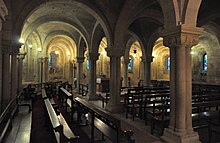Verdun Cathedral
|
View from the cloister |
|
| Basic data | |
| Denomination | Roman Catholic |
| place | Verdun, France |
| diocese | Diocese of Verdun |
| Building history | |
| start of building | 990 |
| Building description | |
| Architectural style | Romanesque |
| Function and title | |
| 49 ° 9 '34.7 " N , 5 ° 22' 57.5" E | |
The Verdun Cathedral ( Basilique-Cathédrale de Notre-Dame ), episcopal church of the Roman Catholic diocese of Verdun , stands on a rocky outcrop in the Lorraine city of Verdun . It is the oldest cathedral in Lorraine and the largest essentially Romanesque building in eastern France. It has been listed as a Monument historique since 1906 .
History and architecture
Verdun has been a bishopric since the 4th century. In the 10th century, the then cathedral burned down and lost most of its books. This early church was already called Notre-Dame de Verdun, Latin Sanctae Mariae in Virduno and already had an underground crypt with an altar of Mary . Bishop Haimo ordered the construction of today's cathedral around 990. In a construction period of around 150 years, interrupted by a fire in 1047, a basilica in the style of the Rhenish Romanesque was built with two choirs , two transepts , two crypts and four towers. The eastern choir was completed in the 12th century. It is flanked by two portals, the John and the Lion Portals, which with their western counterparts symbolize the four Evangelists. On November 11, 1147 the cathedral of Pope Eugene III. consecrated .
In the course of the 14th and 15th centuries, the flat wooden ceiling of the 94 meter long nave was replaced by stone vaults, the aisles were given a new roof, the windows were enlarged and the interior was decorated with frescoes. In addition, the building was expanded with Gothic side chapels. In the 16th century the presumably early Romanesque old cloister was replaced by a new building in the flamboyant style .
On April 2, 1755, a lightning strike and the ensuing great fire destroyed the roofs and towers of the cathedral. During the restoration from 1760, only two of the four towers were rebuilt, now in the style of the French classicist baroque . In the same way, the considerable damage to the nave was repaired and the interior was renewed. The altar ciborium, modeled on St. Peter's Basilica in Rome , also dates from this period .
During the First World War , numerous shell hits damaged the cathedral. The restoration lasted from 1920 to 1935. Most of the baroque interior was removed. The crypt, which had been filled in by then, was exposed again and received modern column heads, which u. a. Depicting battle scenes from the period 1914 to 1918.
In 1947, 800 years after her consecration, Pope Pius XII awarded Notre-Dame de Verdun the title of minor basilica . The millennium of its founding was celebrated in 1990 with large ecclesiastical and cultural events.
organ
The large organ was built in 1935 by the Jacquot organ builder and inaugurated by Marcel Dupre. It has 64 stops on four manual works and a pedal . The playing and stop actions are electro-pneumatic.
|
|
|
|
|
||||||||||||||||||||||||||||||||||||||||||||||||||||||||||||||||||||||||||||||||||||||||||||||||||||||||||||||||||||||||||||||||||||||||||||
- Coupling : I / I (sub and super octave coupling), II / I, III / I (also as sub and super octave coupling), III / II, III / III (sub and super octave coupling), IV / I, IV / II, IV / III, I / P, II / P, III / P, IV / P
literature
- Hubert Collin: La cathédrale Notre-Dame de Verdun presented at Congrès archéologique de France , 149ème session, 1991.
- Histoire de l'architecture français (Volume 1), Editions du Patrimoine, Mengès, Paris (1995), ISBN 2-85620-367-1 .
- Hans-Günter Marschall: The Cathedral of Verdun. Publications by the Institute for Regional Studies in Saarland, Saarbrücken 1981.
- Hans-Günter Marschall: La Cathédrale de Verdun. Sous le patronage de la Société Philomatique de Verdun, 2009.
Web links
- Building history (website of the cathedral, French)
- Verdun Cathedral (structurae.net)
Individual evidence
- ^ Entry Monuments historiques
- ↑ a b Bertharius. Excerptum Domni Bertarii Scaerdotis in gestis pontificum S. Virudensis Ecclesiae ad domnum Dadonem Ejusdem sedis antistitem . In: Jacques-Paul Migne. Patrologiae Cursus Completus: Series Latina: Sive, Bibliotheca Universalis, Integra, Uniformis, Commoda, Oeconomica, Omnium SS. Patrum, Doctorum Scriptorumque Ecclesiasticorum Qui Ab Aevo Apostolico Ad Usuque Innocentii III Tempora Floruerunt . Volume 132. Migne, 1853. pp. 507ff. ( online )
- ↑ More information about the organ




